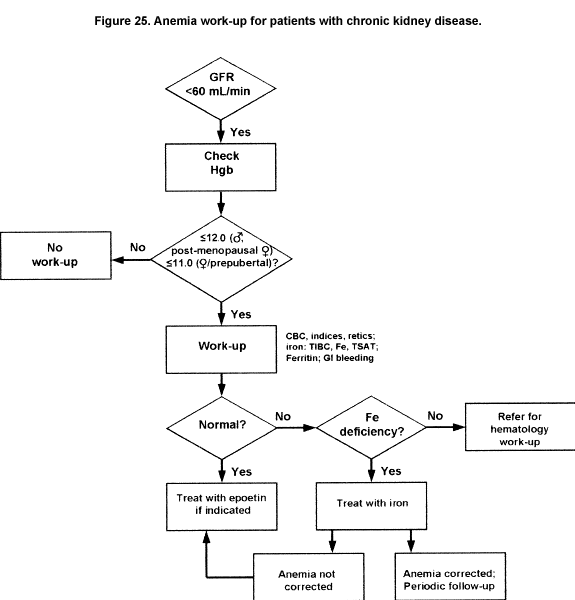

Neutrophils are important components of innate immunity and respond rapidly to injury. The role of immune cells in the pathogenesis of AKI has been highlighted in several animal models, in which direct or indirect inhibition of immune cells attenuated renal injury. Local and systemic inflammation plays a significant part in the initiation and extension phases of AKI, in the multi-organ failure associated with AKI and also in the progression to chronic kidney disease which can result if these immune mechanisms persist.
#LOW HEMATOCRIT AND HEMOGLOBIN IN RENAL INJURY PRO#
In addition, they produce pro and anti-inflammatory cytokines that further increase or decrease inflammation in the kidney. These cells cause ischemic tubular epithelial and endothelial injury directly and indirectly by releasing oxygen radicals, prostaglandins, leukotrienes, and thromboxanes. The initial damage to renal endothelial cells and proximal tubular epithelial cells produces cytokines resulting in infiltration of inflammatory cells, such as neutrophils, lymphocytes, and macrophages into the interstitium. The immunopathogenesis of AKI involves a complex interaction of damage-associated molecular patterns, pathogen-associated molecular patterns, oxidative stress, hypoxia inducible factor, complement system, dendritic cells, neutrophils, lymphocytes, macrophages, platelets, and cytokines. In recent years, the significant role of inflammation in the pathophysiology of AKI has been emphasized. Most cases are multifactorial and following the inciting event numerous pathophysiologic events occur, including hemodynamic instability, microcirculatory dysfunction, tubular cell injury, tubular obstruction, renal congestion, microvascular thrombi, endothelial dysfunction, and inflammation. Ī comprehensive understanding of the pathophysiology is critical to identify easily available predictors of AKI to prevent, diagnose, and treat this complication, ultimately improving patient outcomes.ĪKI can be systematized clinically into three groups: prerenal, which accounts for up to 60% of cases and results from the functional adaptation to hypoperfusion of structurally normal kidneys intrinsic renal results from structural damage to any component of the renal parenchyma and accounts for up to 40% of cases and less frequently postrenal resulting from urinary tract obstruction. These have been evaluated and validated in multiple settings, though their use in clinical practice is limited due to the associated costs and lack of evidence of better patient outcomes with their use in detecting AKI. Therefore, research has focused on the development of new biomarkers, including Cystatin-C, neutrophil gelatinase-associated lipocalin (NGAL), N-acetyl-glucosaminidase (NAG), kidney injury molecule 1 (KIM-1), interleukin-6 (IL-6), interleukin-8 (IL-8), interleukin 18 (IL-18), liver-type fatty acid-binding protein (L-FABP), calprotectin, urine angiotensinogen (AGT), urine microRNAs, insulin-like growth factor-binding protein 7 (IGFBP7), and tissue inhibitor of metalloproteinases-2 (TIMP-2). UO depends on patient’s volemic and haemodynamic status and use of diuretics, is difficult to assess without a urinary catheter and its usefulness relies on an hourly assessment which is time-consuming.

SCr is an insensitive and delayed marker which is altered by factors affecting its production (age, gender, diet, and muscle mass), elimination (previous renal dysfunction), and secretion (medications). The definition of AKI depends on SCr and UO, which are imperfect markers of AKI. Given its impact on prognosis, it is important to recognize risk factors for its occurrence, such as advanced age, diabetes, hypertension, chronic kidney disease (CKD), cardiovascular disease (CVD), liver disease, lung disease, disease severity, sepsis, shock, nephrotoxicity, and surgery (Table 1). Nevertheless, mortality rates are significant and increase with AKI severity, specifically in dialysis-requiring AKI.

Overall, mortality rates associated with AKI have decreased reflecting the impact of the increased recognition of this diagnosis and improvements in patient care. ĪKI has a negative impact in patient outcomes in the short and long term, increasing the risk of in-hospital mortality, longer hospital stays, cardiovascular events, progression to chronic kidney disease, and long-term mortality. The incidence of AKI has raised in the past decades, occurring in up to 20% of hospitalized patients and the incidence is higher in critically ill patients. Acute kidney injury (AKI) is a complex syndrome defined as a rapid decrease in renal function, caused by numerous etiologies.


 0 kommentar(er)
0 kommentar(er)
